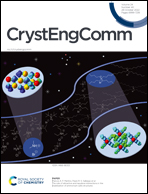The role of attractive and repulsive interactions in the stabilization of ammonium salts structures†
Abstract
This study proposes an approach with the necessary steps to answer some questions: (i) how to build a proper demarcation for the study of salts since there are two ionic entities? (ii) would it be possible to build a proposal for a crystallization mechanism for salts, similar to the one for uncharged organic compounds? (iii) considering that destabilizing interactions between ionic salt species are expected, how to consider this in a proposal for a crystallization mechanism? Thus, a series of ammonium salts containing halide anions as models were used in this study. These models allow the modulation of the organic part of the salt, allowing the evaluation of different patterns of electrostatic potential dispersion in the ammonium cation. It was possible to propose a step-by-step approach to determine the stabilization energy and contact area data from the crystal structures and be able to propose crystallization mechanisms for these kinds of structures. Moreover, a new parameter was presented to assess the cluster energy efficiency (CEE), allowing the proposal of an efficiency hierarchy and a comparison with uncharged organic molecules. As such, ammonium salts with large alkyl groups lead to a salt-without-charge-like supramolecular behavior; otherwise, the absence of carbon chains in nitrogen and/or the presence of N–H leads to a salt-with-charge-like supramolecular behavior. The electrostatic complementarity was explored via molecular electrostatic potential maps. Finally, it was possible to build the supramolecular clusters and propose crystallization mechanisms for all 27 compounds, corroborating the proposed demarcation and helping to understand the crystalline structures of the studied ammonium salts.



 Please wait while we load your content...
Please wait while we load your content...